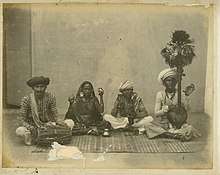Playing by ear
Playing or learning by ear is the ability of a performing musician to reproduce a piece of music they have heard, without having seen it notated in any form of sheet music.[1] It is considered to be a desirable skill among musical performers.[2]
Many forms of classical music throughout the world are fundamentally rooted in the concept of playing by ear, where musical compositions are passed down from generation to generation. In this respect, playing by ear can be also seen as a music-specific example of oral tradition. However, there are some examples of musical traditions where greater importance is placed on a tradition of writing down the music, in some form of musical notation.
The concept of playing by ear has led to the development of the idiom, to play by ear.
Method
Learning music by ear is done by repeatedly listening to other musicians, either their live shows or sound recordings of their songs, and then attempting to recreate what one hears. Audiation involves hearing sounds mentally, although on a different level than just "hearing a song in one's head". The skill of reproducing those sounds involves the ability to mentally hear and recognize rhythms, tell the interval between a note and a reference note in a melody, play a specific interval between a melodic note and bass note (typically 1, 3, or 5 intervals below the melodic note), and play the notes of a specific chord based on the a given bass note (e.g., notes at 1, 3, and 5 intervals above the bass note).
Existence in classical music traditions
In most instances, those traditions where learning music from playing by ear is paramount do not use musical notation in any form. Some examples of this such as by early Blues guitarists and pianists, Romani fiddlers and folk music guitarists.

(c. 1870)
One particularly prominent example is of Indian classical music, where the teaching methods of its two major strands (Hindustani and Carnatic) are almost exclusively oral.[3]
Western classical music
Historically, the Western classical music tradition has been based on the process of learning new pieces from musical notation, and hence playing by ear has a lower importance in musical training.
However, many teaching methods in this tradition incorporate playing by ear in some form. Examples include the "ear training" courses that are a standard part of conservatory or college music programs (including use of Solfège), and the Suzuki method, which incorporates a highly developed focus on playing by ear from a very young age.
In the West, learning by ear is also associated with the genres of folk music, blues, rock, and jazz.
See also
References and notes
- ↑ "Play by ear - Idioms by the Free Dictionary". thefreedictionary.com. Retrieved 23 September 2018.
- ↑ "Playing By Ear: How to learn to play notes and chords by ear - Musical U". Musical U. Retrieved 23 September 2018.
- ↑ "ITC Sangeet Research Academy - Indian Oral Tradition". www.itcsra.org. Retrieved 23 September 2018.
External links
- Description of Audiation from the Gordon Institute for Music Learning
- Basic introduction to playing by ear by Allan Jeong Professor of Instructional Systems & Learning Technology